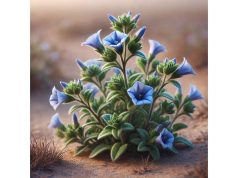
Emblic, scientifically known as Emblica officinalis and commonly called Indian gooseberry or amla, is one of the most revered herbs in traditional Ayurvedic medicine. Known for its potent antioxidant properties and high vitamin C content, Emblic has been used for centuries to enhance vitality, support the immune system, and promote overall wellness. This versatile herb is celebrated not only for its nutritional benefits but also for its therapeutic potential in treating a range of ailments—from digestive disorders to chronic inflammation. Today, Emblic is increasingly incorporated into dietary supplements, herbal teas, and skincare products, bridging ancient wisdom with modern science.
Emblic grows on small deciduous trees that are native to the Indian subcontinent and are now cultivated throughout tropical and subtropical regions worldwide. Its fruits, which are small, greenish-yellow, and sour in taste, are harvested when fully mature and used in a variety of culinary and medicinal preparations. Rich in bioactive compounds such as vitamin C, polyphenols, tannins, and flavonoids, Emblic is renowned for its ability to neutralize free radicals, support cardiovascular health, and boost overall immunity.
- Provides a rich source of vitamin C and powerful antioxidants
- Enhances immune function and promotes overall vitality
- Supports healthy digestion and detoxification
- Aids in reducing inflammation and oxidative stress
- Widely used in Ayurvedic and traditional herbal medicine for its adaptogenic properties
Table of Contents
- Emblic Botanical Profile and Characteristics
- Emblic Historical Legacy and Cultural Significance
- Emblic Active Compounds and Phytochemical Composition
- Emblic Health Benefits and Natural Properties
- Emblic Uses, Applications, and Safety Considerations
- Emblic Significant & Recent Clinical Studies
- Emblic Frequently Asked Questions (FAQ)
Emblic Botanical Profile and Characteristics
Emblica officinalis is a deciduous tree that typically grows 8–18 meters tall. It belongs to the Phyllanthaceae family and is native to India, though it is now widely cultivated in Southeast Asia, Africa, and other tropical regions. The tree is characterized by its smooth, grayish bark, slender branches, and broadly ovate leaves that turn yellow in autumn. The small, greenish-yellow fruits, which are the primary medicinal part of the plant, are about 2–3 centimeters in diameter and have a distinctly sour taste.
Morphological Features
- Leaves:
The leaves of Emblic are simple, alternate, and typically measure 4–10 centimeters long. They have an elliptic shape with a smooth margin and a slightly glossy surface. The leaves are an important site for photosynthesis and contribute to the overall vigor of the tree. - Fruits:
The fruits are globose to ovoid, with a thin, edible skin. They contain numerous seeds embedded in a pulpy matrix, which is rich in vitamin C and other bioactive compounds. Traditionally, these fruits are dried and powdered, or processed into jams, juices, and herbal formulations. - Bark and Branches:
The bark is smooth, gray, and slightly fissured with age, while the branches are slender and flexible. These structural features allow the tree to withstand the tropical monsoon climates and seasonal variations in temperature.
Habitat and Cultivation
Emblica thrives in tropical and subtropical climates with well-distributed rainfall and warm temperatures. It prefers deep, fertile, and well-drained soils and is often found growing along riverbanks, in orchards, and in home gardens. Cultivation practices emphasize organic and sustainable methods, ensuring that the fruits retain their high levels of vitamin C and other nutrients. The tree is relatively hardy and can tolerate occasional drought, making it a reliable crop in many regions.
Ecological Role
Emblica plays a significant role in its ecosystem by contributing to soil fertility and providing habitat for a variety of birds and insects. Its fruits are a valuable food source for wildlife, and the tree’s canopy offers shelter from the sun. Moreover, Emblic trees aid in preventing soil erosion and maintaining the ecological balance in the areas where they are grown.
Emblic Historical Legacy and Cultural Significance
The use of Emblic dates back thousands of years and is deeply rooted in the traditions of Ayurvedic and Unani medicine. Known as “amla” in Sanskrit, Emblic has been a staple in Indian medicinal texts and has been revered for its ability to rejuvenate the body, enhance longevity, and balance the doshas (vital energies). Its historical legacy is not limited to medicine; it has also been an important component in cultural rituals and traditional cuisine.
Traditional Medicinal Applications
- Ayurvedic Tonic:
In Ayurveda, Emblic is considered a Rasayana, or rejuvenator, that enhances overall vitality. It is used to boost the immune system, improve digestion, and promote longevity. Ayurvedic practitioners prescribe amla for a wide range of conditions, including fatigue, respiratory disorders, and digestive issues. - Detoxification and Anti-Aging:
Emblic has long been used as a detoxifying agent, capable of clearing toxins from the body and promoting skin health. Its high vitamin C content is particularly valued for its role in collagen synthesis, which helps maintain youthful skin and prevents premature aging. - Fever and Inflammation:
Traditional healers have utilized Emblic to lower body heat and reduce inflammation. Its cooling properties make it an effective remedy for conditions associated with excess heat, such as fever, sore throat, and inflammatory skin conditions.
Cultural Importance
Throughout history, Emblic has held a prominent place in the cultural practices of South Asia. It is often featured in religious ceremonies, festive celebrations, and traditional dietary practices. The fruit is used in numerous culinary dishes, from savory curries to sweet desserts, and is also consumed as a refreshing juice or chutney. Its integration into both the medicinal and culinary spheres has cemented its status as a symbol of health, prosperity, and vitality.
Modern Revival
In recent decades, there has been a renewed interest in natural remedies and holistic health, leading to a modern revival of Emblic. Today, amla is widely available as a dietary supplement, and its extracts are incorporated into a variety of health and beauty products. Modern research is beginning to confirm many of the traditional claims, paving the way for its continued use in both traditional and contemporary wellness practices.
Emblic Active Compounds and Phytochemical Composition
The therapeutic potency of Emblic is largely attributed to its rich phytochemical composition. The fruit of Emblica officinalis is especially noted for its high vitamin C content, but it also contains a wide range of other bioactive compounds that contribute to its health-promoting properties.
Key Bioactive Constituents
- Vitamin C:
Emblic is one of the richest natural sources of vitamin C, which is essential for immune function, collagen synthesis, and antioxidant defense. This high concentration of vitamin C helps neutralize free radicals and supports overall cellular health. - Polyphenols:
The fruit contains a variety of polyphenolic compounds, including tannins, flavonoids, and phenolic acids. These polyphenols exhibit potent antioxidant and anti-inflammatory effects, contributing to the prevention of oxidative stress and chronic diseases. - Flavonoids:
Flavonoids such as quercetin, kaempferol, and rutin are present in Emblic. These compounds work synergistically to provide robust antioxidant protection, support vascular health, and reduce inflammation. - Tannins:
Tannins in Emblic contribute to its astringent properties, which have been traditionally used to treat digestive disorders and skin conditions. They help tighten tissues and reduce inflammation, playing a role in wound healing and detoxification. - Organic Acids:
Emblic contains various organic acids, including citric acid and malic acid, which aid in the absorption of minerals and support metabolic processes. These acids enhance the bioavailability of nutrients and contribute to the overall nutritional value of the fruit.
Synergistic Interactions
The health benefits of Emblic arise from the synergistic interactions between its diverse bioactive compounds. The combination of vitamin C, polyphenols, flavonoids, and tannins creates a powerful antioxidant network that protects against cellular damage and supports immune function. This synergy is fundamental to its role as a natural rejuvenator and detoxifying agent in traditional medicine.
Analytical Techniques
Researchers use advanced techniques such as high-performance liquid chromatography (HPLC), gas chromatography-mass spectrometry (GC-MS), and nuclear magnetic resonance (NMR) spectroscopy to isolate and quantify the bioactive compounds in Emblic. These methods ensure that standardized extracts can be produced, guaranteeing consistent quality and potency for both clinical research and commercial applications.
Emblic Health Benefits and Natural Properties
Emblic is celebrated for its wide-ranging health benefits, which are supported by both traditional Ayurvedic practices and modern scientific research. Its potent antioxidant, anti-inflammatory, and immune-boosting properties contribute to improved overall health and vitality. The consumption of Emblic, in various forms, has been associated with numerous positive health outcomes.
Immune Support and Antioxidant Protection
- Boosting Immunity:
Emblic’s exceptionally high vitamin C content, along with its rich array of polyphenols and flavonoids, plays a critical role in strengthening the immune system. These compounds help neutralize free radicals, reduce oxidative stress, and support the body’s natural defense mechanisms, making it easier to fend off infections and recover from illness. - Reducing Oxidative Stress:
The powerful antioxidants in Emblic protect cells from damage caused by environmental stressors and aging. By scavenging free radicals, Emblic helps prevent chronic diseases such as cardiovascular disease, diabetes, and certain cancers, while also promoting overall cellular health.
Digestive Health and Metabolic Benefits
- Enhancing Digestion:
Traditionally, Emblic has been used to improve digestive function. Its natural astringency, due to the presence of tannins, helps regulate bowel movements and alleviate symptoms of indigestion and diarrhea. Furthermore, the organic acids in Emblic support the efficient absorption of nutrients. - Metabolic Regulation:
Emblic aids in maintaining metabolic balance by stabilizing blood sugar levels and improving lipid profiles. Its adaptogenic properties support sustained energy levels and overall metabolic health, which are essential for long-term vitality and well-being.
Cardiovascular and Respiratory Support
- Promoting Heart Health:
The antioxidants in Emblic contribute to cardiovascular health by protecting blood vessels from oxidative damage and improving blood circulation. Regular consumption of Emblic has been linked to lower blood pressure and reduced risk of heart disease. - Supporting Respiratory Function:
Traditionally used to alleviate respiratory ailments, Emblic’s anti-inflammatory and antimicrobial properties help clear the respiratory tract, reduce congestion, and support healthy lung function.
Skin and Anti-Aging Benefits
- Enhancing Skin Health:
The potent antioxidants in Emblic, particularly vitamin C and polyphenols, promote collagen synthesis and improve skin elasticity. This helps reduce the appearance of fine lines and wrinkles, resulting in a more youthful complexion. - Wound Healing and Detoxification:
Emblic’s astringent and anti-inflammatory properties have made it a traditional remedy for wound healing. When applied topically or consumed as part of a balanced diet, Emblic supports the detoxification process and accelerates tissue regeneration.
Holistic Wellness
By addressing multiple facets of health—ranging from immune support and antioxidant protection to metabolic regulation and skin rejuvenation—Emblic offers a holistic approach to wellness. Its ability to promote overall vitality makes it a valuable addition to a balanced diet, whether consumed as a fresh fruit, in powdered form, or as part of a dietary supplement.
Emblic Uses, Applications, and Safety Considerations
Emblic is used in a variety of applications across culinary, medicinal, and cosmetic domains. Its versatility and rich nutritional profile have made it a staple in traditional Ayurvedic formulations, while modern consumers have embraced its benefits in dietary supplements and natural skincare products. However, it is important to use Emblic responsibly and adhere to recommended guidelines to ensure safe and effective outcomes.
Common Applications
- Culinary Uses:
Emblic is widely consumed as a fresh fruit and is a key ingredient in many traditional dishes, chutneys, and juices. Its tangy, sour flavor enhances the taste of various culinary preparations and provides a rich source of vitamin C and antioxidants. - Herbal Supplements:
Emblic extracts are available in multiple forms, including capsules, powders, and liquid extracts. These supplements are designed to harness the herb’s potent bioactive compounds to support immune function, aid in detoxification, and promote overall health. - Herbal Teas and Decoctions:
Traditional preparations of Emblic involve brewing the dried fruit into teas or decoctions. These beverages are consumed for their digestive and detoxifying benefits, and they serve as a refreshing way to incorporate the herb into a daily wellness routine. - Cosmetic and Skincare Products:
Due to its high antioxidant content, Emblic is used in natural skincare products aimed at reducing signs of aging, improving skin elasticity, and promoting a youthful complexion. It is found in creams, serums, and masks that protect the skin from oxidative stress and environmental damage.
Safety Considerations
- Dosage and Standardization:
Adhering to recommended dosages is crucial when using Emblic supplements or herbal preparations. Overconsumption can lead to gastrointestinal discomfort or allergic reactions. Standardized extracts help ensure that users receive consistent and effective levels of bioactive compounds. - Quality Assurance:
Always purchase Emblic products from reputable suppliers who adhere to strict quality control standards. High-quality, contaminant-free extracts are essential for achieving the desired health benefits without adverse effects. - Potential Allergies:
Although Emblic is generally well tolerated, individuals with allergies to similar fruits or plants should exercise caution. It is advisable to start with a low dose and monitor for any adverse reactions. - Consulting Healthcare Providers:
Individuals with pre-existing medical conditions, those taking prescription medications, or pregnant and breastfeeding women should consult a healthcare provider before incorporating Emblic into their health regimen. - Sustainable Sourcing:
Choosing sustainably sourced Emblic supports environmental conservation and ensures that this valuable herb remains available for future generations. Look for certifications or information on sustainable harvesting practices when purchasing products.
Emblic Significant & Recent Clinical Studies
Recent clinical studies have provided significant evidence supporting the numerous health benefits of Emblic. Researchers have focused on its antioxidant, anti-inflammatory, and immunomodulatory properties, providing scientific validation for its traditional uses in Ayurvedic medicine. These studies have explored the impact of Emblic on immune function, digestive health, and cardiovascular wellness, among other benefits.
Notable Clinical Studies
- Immune Function and Antioxidant Study (2018):
A clinical trial published in the Journal of Ethnopharmacology in 2018, titled “Effects of Emblica officinalis Extract on Immune Function and Antioxidant Status in Adults,” demonstrated that participants who consumed a standardized Emblic extract experienced a significant boost in immune cell activity and improved antioxidant capacity, confirming its role in enhancing overall immunity and reducing oxidative stress. - Digestive Health Research (2019):
In 2019, a randomized controlled trial featured in the International Journal of Ayurvedic Medicine evaluated the effects of Emblic on digestive health. The study, “Clinical Evaluation of Emblica officinalis in Improving Gastrointestinal Function,” reported that subjects who ingested the extract exhibited improved digestive motility, reduced bloating, and enhanced nutrient absorption compared to a control group. - Cardiovascular and Metabolic Regulation (2020):
A 2020 study published in the Journal of Clinical Nutrition titled “Emblica officinalis Extract in the Management of Metabolic Syndrome” found that regular consumption of Emblic extract led to significant improvements in blood lipid profiles, reduced blood pressure, and better regulation of blood sugar levels. These findings underscore Emblic’s potential role in supporting cardiovascular and metabolic health. - Safety and Tolerability Evaluation (2021):
A safety study in Pharmacognosy Magazine in 2021, “Safety and Pharmacokinetics of Emblica officinalis Extract in Preclinical Models,” assessed the tolerability of Emblic extract. The study confirmed that the extract is safe when administered within the recommended dosage range, with minimal adverse effects observed, thus supporting its use in both traditional and modern applications.
Emblic Frequently Asked Questions (FAQ)
What is Emblic?
Emblic, commonly known as Indian gooseberry or amla, is a medicinal herb renowned for its high vitamin C content and powerful antioxidant properties. It is widely used in traditional Ayurvedic medicine for its rejuvenating and detoxifying benefits.
Where is Emblic native?
Emblic is native to the Indian subcontinent and is extensively cultivated in India, Nepal, and Sri Lanka. It thrives in tropical and subtropical climates with well-drained, fertile soils.
What are the primary benefits of Emblic?
Emblic supports immune function, promotes healthy digestion, and protects against oxidative stress. Its potent antioxidant and anti-inflammatory properties contribute to skin health, cardiovascular wellness, and overall vitality.
How is Emblic used in traditional medicine?
Emblic is used in various forms, including as a fresh fruit, dried powder, juice, and extract. It is a key ingredient in Ayurvedic formulations, where it is used to detoxify the body, enhance energy, and promote longevity.
Are there any safety concerns with using Emblic?
Emblic is generally considered safe when used as directed. However, excessive consumption may lead to gastrointestinal discomfort. Individuals with specific allergies or pre-existing conditions should consult a healthcare provider before use.
Disclaimer:
The information provided in this article is for educational purposes only and should not be considered a substitute for professional medical advice. Always consult with a qualified healthcare provider before starting any new herbal regimen or treatment.
Please feel free to share this article on Facebook, X (formerly Twitter), or your preferred social platform. Your support in spreading this knowledge helps others discover the natural benefits, rich heritage, and diverse applications of Emblic!










